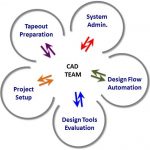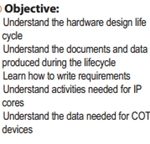The annual Design Automation Conference (DAC) is a big deal and should be of interest to students considering a career in developing software to help automate some of the toughest design and verification challenges in SoC design. Maybe the cost of attending and traveling to DAC is an issue for you. The organizers of DAC are continuing… Read More
Electronic Design Automation
The CAD Team – Unsung Heroes in a Successful Tapeout
For most of my career, I worked as a CAD and design flow engineer. In the fall of 2012, I moved to a different role, as an applications and support manager at ClioSoft Inc. In my opinion, this was a very good opportunity for me to work with other CAD engineers and teams.
Having worked with different CAD teams in my career, I have often felt… Read More
Synchronizer Reliability Metrics
As an example of the need for real-world reliability metrics, consider a modern automobile. We can already buy a car with parking assistance, collision avoidance, autonomous braking and adaptive cruise control features. These new features depend on video image processing that requires high-performance SoC components where… Read More
Mentor Acquires BDA!
Mentor Graphics acquired Berkeley Design Automation this morning. The details of the deal were unannounced. This is a strong move by Mentor to challenge Cadence and Synopsys in the nanometer analog/mixed-signal market and nanometer memory characterization market, respectively. Mentor not only acquires the technology and… Read More
DAC: Automotive, IP and Security
DAC is in the first week of June in San Francisco as I’m sure you already know if you are reading this. Historically DAC has focused on electronic design automation (EDA) and embedded software and systems (ESS). This year there are three new areas: automotive, Intellectual Property (IP) and security.
Automotive
Ever increasing… Read More
Evaluate MEMS Devices out-of-fab Before Fabrication
MEMS design and fabrication is highly complex in the sense that the fabrication process heavily depends on the design, unlike IC fabrication which has a standard set of processes. A slight change in MEMS design can alter its fabrication steps to a large extent. For example, setting device parameters such as capacitance or linear… Read More
ARM, Cadence and the Internet of Things
There is clearly a lot of hype about the Internet of Things (IoT) right now, but also it is clear that it will be a real market. In fact, it already is with various medical, fitness and home-appliance products already available. At CES in January, wearables was probably the biggest trend. That doesn’t always pan out (3D TV was… Read More
TLM Modeling Environment Goes Commercial
The most successful EDA companies typically choose a domain where they have deep knowledge, then serve a few leading-edge customers that are willing to work with a start-up in exchange for early access to that new technology. The theory is that if you can satisfy the leading-edge customer then you can also satisfy the rest of the … Read More
Triple Patterning
As you can’t have failed to notice by now, 28nm is the last process node that does not require double patterning. At 20nm and below, at least some layers require double patterning. The tightest spacing is typically not the transistors but the local interconnect and, sometimes, metal 1.
In the litho world they call double patterning… Read More
Aldec the leader in DO254
I am convinced after studying out the matter, that Aldec is one of the leaders in DO254 certification. As you listen and read the news as I do about flight MA-370, you keep theorizing and wondering. This is a good time to introduce the reader to the seriousness of flight worthy electronics and the arduous process to achieve certification.… Read More








Jensen Huang Drops Donald Trump Truth Bomb on Joe Rogan Podcast